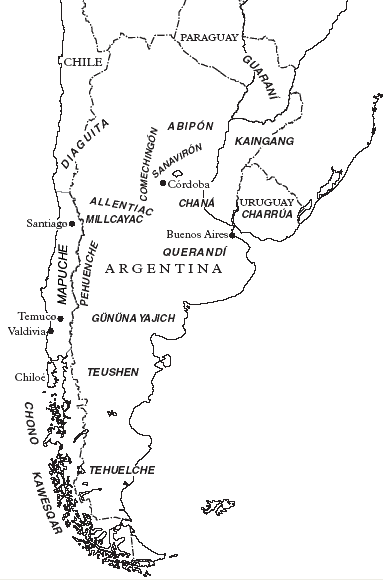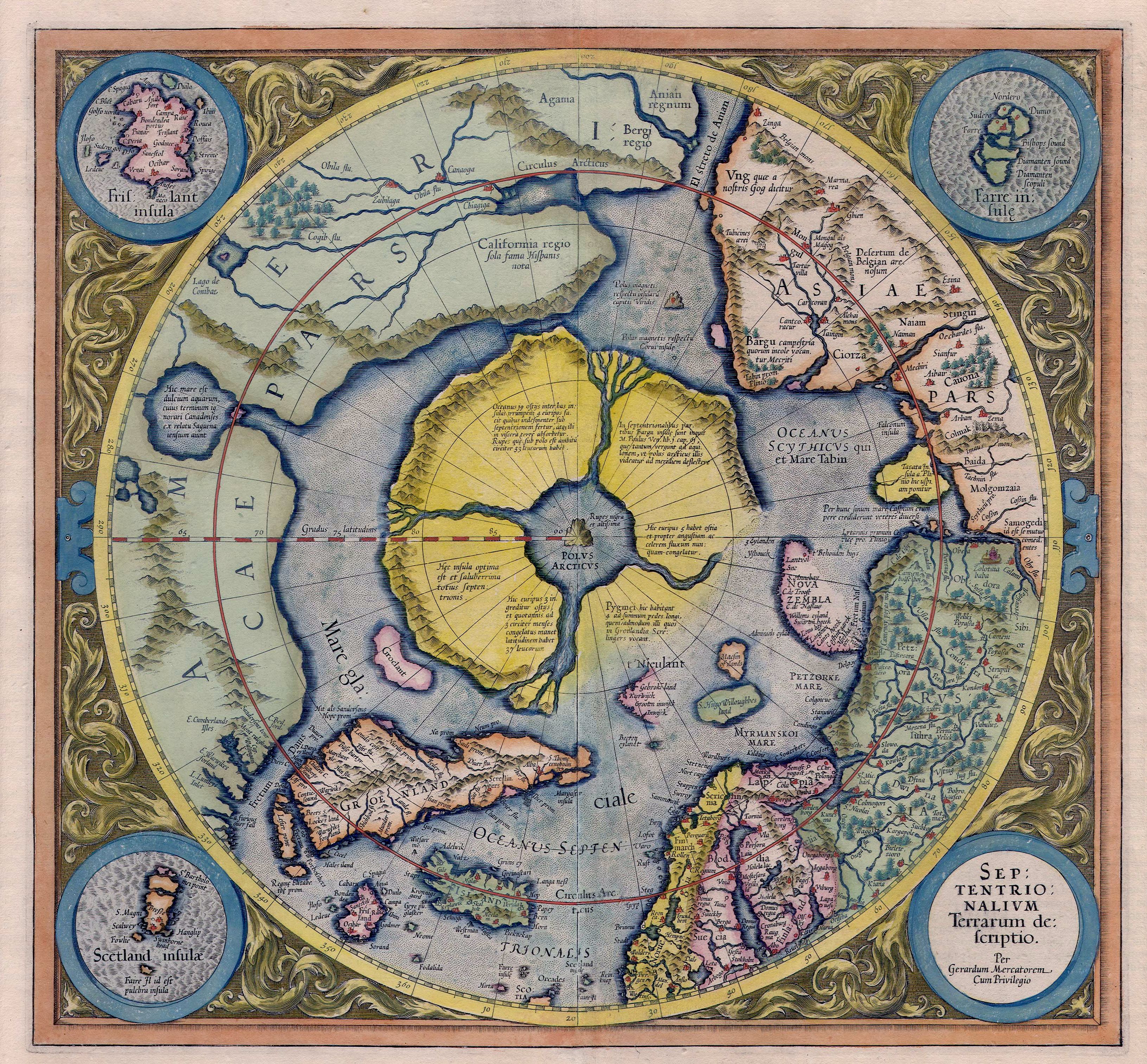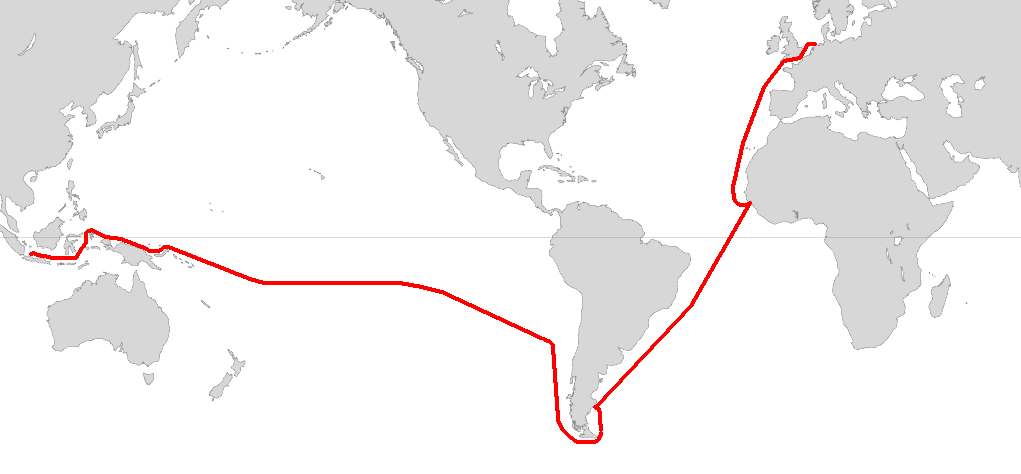|
Patagon
The Patagones or Patagonian giants were a race of giant humans rumoured to be living in Patagonia and described in early European accounts. They were said to have exceeded at least double normal human height, with some accounts giving heights of or more. Tales of these people would maintain a hold upon European conceptions of the region for nearly 300 years. History The first mention of these people came from the voyage of Ferdinand Magellan and his crew, who claimed to have seen them while exploring the coastline of South America en route to the Maluku Islands in their circumnavigation of the world in the 1520s. Antonio Pigafetta, one of the expedition's few survivors and the chronicler of Magellan's expedition, wrote in his account about their encounter with natives twice a normal person's height: Pigafetta also recorded that Magellan had bestowed on these people the name "Patagão" (i.e. "Patagon", or ''Patagoni'' in Pigafetta's Italian plural), but he did not further elab ... [...More Info...] [...Related Items...] OR: [Wikipedia] [Google] [Baidu] |
Patagonia
Patagonia () refers to a geographical region that encompasses the southern end of South America, governed by Argentina and Chile. The region comprises the southern section of the Andes Mountains with lakes, fjords, temperate rainforests, and glaciers in the west and deserts, tablelands and steppes to the east. Patagonia is bounded by the Pacific Ocean on the west, the Atlantic Ocean to the east, and many bodies of water that connect them, such as the Strait of Magellan, the Beagle Channel, and the Drake Passage to the south. The Colorado and Barrancas rivers, which run from the Andes to the Atlantic, are commonly considered the northern limit of Argentine Patagonia. The archipelago of Tierra del Fuego is sometimes included as part of Patagonia. Most geographers and historians locate the northern limit of Chilean Patagonia at Huincul Fault, in Araucanía Region.Manuel Enrique Schilling; Richard WalterCarlson; AndrésTassara; Rommulo Vieira Conceição; Gustavo Walter Berto ... [...More Info...] [...Related Items...] OR: [Wikipedia] [Google] [Baidu] |
Tehuelche People
The Tehuelche people, also called the Aónikenk, are an indigenous people from eastern Patagonia in South America. In the 18th and 19th centuries the Tehuelche were influenced by Mapuche people, and many adopted a horseriding lifestyle. Once a nomadic people the lands of the Tehuelche were colonized in the 19th century by Argentina and Chile gradually disrupting their traditional economies. The establishment of large sheep farming estates in Patagonia was particularly detrimental to the Tehuelche. Contact with outsiders also brought in infectious diseases ushering deadly epidemics among Tehuelche tribes. Most existing members of the group currently reside the in cities and towns of Argentine Patagonia. The name "Tehuelche complex" has been used by researchers in a broad sense to group together indigenous peoples from Patagonia and the Pampas. Several specialists, missionaries and travelers have proposed grouping them together on account of the similarities in their cultural tra ... [...More Info...] [...Related Items...] OR: [Wikipedia] [Google] [Baidu] |
Tierra Del Fuego
Tierra del Fuego (, ; Spanish for "Land of the Fire", rarely also Fireland in English) is an archipelago off the southernmost tip of the South American mainland, across the Strait of Magellan. The archipelago consists of the main island, Isla Grande de Tierra del Fuego, with an area of , and a group of many islands, including Cape Horn and Diego Ramírez Islands. Tierra del Fuego is divided between Chile and Argentina, with the latter controlling the eastern half of the main island and the former the western half plus the islands south of Beagle Channel and the southernmost islands. The southernmost extent of the archipelago is just north of latitude 56°S. The earliest known human settlement in Tierra del Fuego dates to approximately 8,000 BC. Europeans first explored the islands during Ferdinand Magellan's expedition of 1520. ''Tierra del Fuego'' and similar namings stem from sightings of the many bonfires that the natives built. Settlement by those of European descent ... [...More Info...] [...Related Items...] OR: [Wikipedia] [Google] [Baidu] |
Selk'nam People
The Selk'nam, also known as the Onawo or Ona people, are an indigenous people in the Patagonian region of southern Argentina and Chile, including the Tierra del Fuego islands. They were one of the last native groups in South America to be encountered by migrant Europeans in the late 19th century. In the mid-19th century, there were about 4000 Selk'nam; by 1919 there were 297, and by 1930 just over 100. They are considered extinct as a tribe. The exploration of gold and the introduction of farming in the region of Tierra del Fuego led to genocide of the Selk'nam. Joubert Yantén Gómez, a Chilean mestizo of part Selk'nam ancestry, has taught himself the language and is considered the only speaker; he uses the name ''Keyuk.''Judith Thurman, "A Loss for Words" ''The New Yorker'', 30 March 2015 ... [...More Info...] [...Related Items...] OR: [Wikipedia] [Google] [Baidu] |
John Byron
Vice-Admiral John Byron (8 November 1723 – 1 April 1786) was a British Royal Navy officer and explorer. He earned the nickname "Foul-Weather Jack" in the press because of his frequent encounters with bad weather at sea. As a midshipman, he sailed in the squadron under George Anson on his voyage around the world, though Byron made it only to southern Chile, where his ship was wrecked. He returned to England with the captain of HMS ''Wager''. He was governor of Newfoundland following Hugh Palliser, who left in 1768. He circumnavigated the world as a commodore with his own squadron in 1764–1766. He fought in battles in the Seven Years' War and the American Revolution. He rose to Vice Admiral of the White before his death in 1786. His grandsons include the poet Lord Byron and George Anson Byron, admiral and explorer, who were the 6th and 7th Baron Byron, respectively. Early career Byron was the second son of William Byron, 4th Baron Byron and Frances Berkeley, the daughte ... [...More Info...] [...Related Items...] OR: [Wikipedia] [Google] [Baidu] |
Hyperborea
In Greek mythology, the Hyperboreans ( grc, Ὑπερβόρε(ι)οι, ; la, Hyperborei) were a mythical people who lived in the far northern part of the known world. Their name appears to derive from the Greek , "beyond Boreas" (the God of the North Wind), although some scholars prefer a derivation from ("to carry over"). Despite their location in an otherwise frigid part of the world, the Hyperboreans were believed to inhabit a sunny, temperate, and divinely-blessed land. In many versions of the story, they lived north of the Riphean Mountains, which shielded them from the effects of the cold North Wind. The oldest myths portray them as the favorites of Apollo, and some ancient Greek writers regarded the Hyperboreans as the mythical founders of Apollo's shrines at Delos and Delphi. Later writers disagreed on the existence and location of the Hyperboreans, with some regarding them as purely mythological, and others connecting them to real-world peoples and places in nor ... [...More Info...] [...Related Items...] OR: [Wikipedia] [Google] [Baidu] |
Puerto Deseado
Puerto Deseado, originally called Port Desire, is a city of about 15,000 inhabitants and a fishing port in Patagonia in Santa Cruz Province of Argentina, on the estuary of the Deseado River. It was named ''Port Desire'' by the privateer Thomas Cavendish in 1586 after the name of his ship, and later became known by the Spanish translation of the name. Today, the straggly town has a couple of pleasant squares, a former railway station and two museums, one with a collection of indigenous artifacts and one at the seafront with relics from the sloop of war HMS ''Swift'' which sank in 1770, recovered after its wreck was discovered in the port in 1982. The coast boasts spectacular scenery and colonies of marine wildlife close to the town. History The harbour, nearly long, was discovered in 1520 by the Spanish expedition commanded by Magellan. Other Spanish expeditions followed, including Pedro Sarmiento de Gamboa. On 17 December 1586 the privateer Thomas Cavendish sailed into t ... [...More Info...] [...Related Items...] OR: [Wikipedia] [Google] [Baidu] |
Francis Drake
Sir Francis Drake ( – 28 January 1596) was an English explorer, sea captain, privateer, slave trader, naval officer, and politician. Drake is best known for his circumnavigation of the world in a single expedition, from 1577 to 1580 (the first English circumnavigation, the second carried out in a single expedition, and third circumnavigation overall). This included his incursion into the Pacific Ocean, until then an area of exclusive Spanish interest, and his claim to New Albion for England, an area in what is now the U.S. state of California. His expedition inaugurated an era of conflict with the Spanish on the western coast of the Americas, an area that had previously been largely unexplored by Western shipping. He was Member of Parliament (MP) for three constituencies; Camelford in 1581, Bossiney in 1584, and Plymouth in 1593. Elizabeth I awarded Drake a knighthood in 1581 which he received on the '' Golden Hind'' in Deptford. In the same year, he was appointed ... [...More Info...] [...Related Items...] OR: [Wikipedia] [Google] [Baidu] |
Willem Schouten
Willem Cornelisz Schouten ( – 1625) was a Dutch navigator for the Dutch East India Company. He was the first to sail the Cape Horn route to the Pacific Ocean. Biography Willem Cornelisz Schouten was born in c. 1567 in Hoorn, Holland, Seventeen Provinces. In 1615 Willem Cornelisz Schouten and his younger brother Jan Schouten sailed from Texel in the Netherlands, in an expedition led by Jacob Le Maire and sponsored by Isaac Le Maire and his ''Australische Compagnie'' in equal shares with Schouten. The expedition consisted of two ships: ''Eendracht'' and ''Hoorn''.Quanchi, ''Historical Dictionary of the Discovery and Exploration of the Pacific Islands'', pp. 222–33 A main purpose of the voyage was to search for ''Terra Australis''. A further objective was to explore a western route to the Pacific Ocean to evade the trade restrictions of the Dutch East India Company (VOC) in the Spice Islands. In 1616 Schouten rounded Cape Horn, which he named after the recently destroye ... [...More Info...] [...Related Items...] OR: [Wikipedia] [Google] [Baidu] |
Sebald De Weert
Sebald or Sebalt de Weert (May 2, 1567 – May 30 or June 1603) was a Flemish captain and vice-admiral of the Dutch East India Company (known in Dutch as ''Vereenigde Oost-Indische Compagnie'', VOC). He is most widely remembered for accurately plotting the Falkland Islands in 1600. Early life Sebald de Weert was born in Antwerp, the sixth of 17 children of Johannes Sweerts de Weert (b. 1538) and Clara Wonderer (1541–1595). The family left Antwerp for Cologne in January 1569, to escape the tyranny and persecution. In 1575, the family moved to Amsterdam. Between 1579 and 1584, they were back in Antwerp, and by 1586, they lived in Middelburg. Sebald was originally employed as a ship's navigator with the Dutch East India Company (VOC), and over the years worked his way up to vice admiral with the VOC. He signed his name "Sebalt", but had the official Latinized name "Sebaldus". Expedition to the East Indies via the Straits of Magellan Crossing the Atlantic Around 1598, sev ... [...More Info...] [...Related Items...] OR: [Wikipedia] [Google] [Baidu] |
Ferdinand Magellan
Ferdinand Magellan ( or ; pt, Fernão de Magalhães, ; es, link=no, Fernando de Magallanes, ; 4 February 1480 – 27 April 1521) was a Portuguese explorer. He is best known for having planned and led the 1519 Spanish expedition to the East Indies across the Pacific Ocean to open a maritime trade route, during which he discovered the interoceanic passage bearing thereafter his name and achieved the first European navigation from the Atlantic to Asia. During this voyage, Magellan was killed in the Battle of Mactan in 1521 in the present-day Philippines, after running into resistance by the indigenous population led from Lapulapu, who consequently became a Philippines national symbol of resistance to colonialism. After Magellan's death, Juan Sebastián Elcano took the lead of the expedition, and with its few other surviving members in one of the two remaining ships, completed the first circumnavigation of Earth when they returned to Spain in 1522. Born 4 February 1480 in ... [...More Info...] [...Related Items...] OR: [Wikipedia] [Google] [Baidu] |
Joris Van Spilbergen
Joris van Spilbergen (1568 in Antwerp – January 31, 1620 in Bergen op Zoom) was a Dutch naval officer. Joris van Spilbergen was born in Antwerp in 1568. His first major expedition was in 1596, when he sailed to Africa. He then left for Asia on 5 May 1601, from Veere, a seaport on the island of Walcheren in Zealand, in command of the fleet of the company of Balthazar de Moucheron (a trading company before the establishment of the VOC). His ships were the ''Ram'', ''Schaap'', and ''Lam''. Spilbergen met the king of Kandy (Sri Lanka) Vimala Dharma Suriya in 1602, and discussed the possibility of trade in cinnamon. In 1607, Spilbergen, onboard ''Aeolus'', was with Jacob van Heemskerk at the Battle of Gibraltar. In 1614, he sailed beyond the Strait of Magellan with an expedition of five ships. Despite the fact that the Twelve Years' Truce between Spain and the Dutch Republic was in force, he raided the Spanish settlements on the coast of Mexico and South America. He foug ... [...More Info...] [...Related Items...] OR: [Wikipedia] [Google] [Baidu] |











